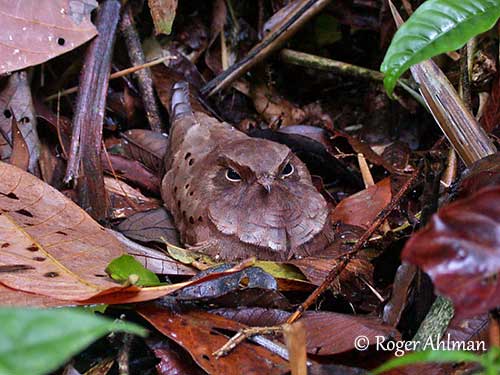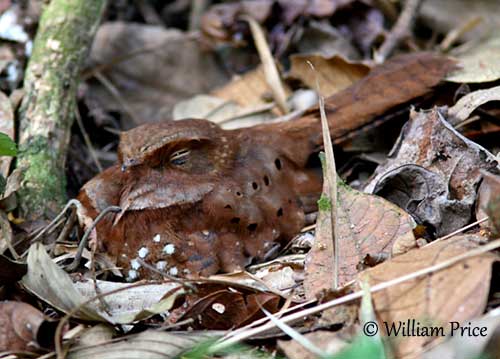
The female lays two whitish to pinkish-white eggs. The pale eggs allow the adults to locate them more easily at night. On the other hand, the pale colour may also attract predators during the day. Some eggs are unmarked, or with faint reddish, brownish or grey spots. Both adults share the incubation during 19-21 days.
The fledging period is unknown, but usually, the nightjar’s chicks often fledge during their third week, and become independent about 25-35 days after hatching.
If a predator threatens the nest, the female performs distraction display, typically the broken-wing display near the nest to deceive the intruder.
PROTECTION / THREATS / STATUS:
The Ocellated Poorwill is difficult to find due to its nocturnal habits.
The species has been recently discovered in E Honduras where it breeds and seems to be fairly common. It is generally local to fairly common throughout the range.
The Ocellated Poorwill is affected by habitat loss caused by deforestation, especially in Central America.
The global population was estimated to number 500,000/4,999,999 mature individuals in 2019 by Partners in Flight. It is generally patchily distributed and the population is declining.
However, the species is not considered globally threatened, and the Ocellated Poorwill is currently evaluated as Least Concern.
Fr: Engoulevent ocellé
Ang: Ocellated Poorwill
All: Augennachtschwalbe
Esp: Chotacabras Ocelado
Ita: Succiacapre ocellato
Nd: Gevlekte Poorwill
Sd: fläcknattskärra
Photographers:
Roger Ahlman
Pbase Galleries Peru and Ecuador
William Price
PBase-tereksandpiper & Flickr William Price
Text by Nicole Bouglouan
Sources:
HANDBOOK OF THE BIRDS OF THE WORLD Vol 5 by Josep del Hoyo-Andrew Elliott-Jordi Sargatal - Lynx Edicions - ISBN: 8487334253
A GUIDE TO THE BIRDS OF COLOMBIA by Steven L. Hilty and William L. Brown - Princeton University Press – ISBN 069108372X
BIRDS OF PERU by Thomas S. Schulenberg, Douglas F. Stotz, Daniel F. Lane, John P. O’Neill, Theodore A. Parker III–Princeton University Press 2007–ISBN: 978-0-691-13023-1
Avibase (Denis Lepage)
Birdlife International
The immature plumage of Ocellated Poorwill Nyctiphrynus ocellatus (Caprimulgidae)
Ocellated Poorwill
Nyctiphrynus ocellatus
Caprimulgiformes Order - Caprimulgidae Family
INTRODUCTION:
The Ocellated Poorwill is a small nightjar found in Central and South America. The New World poorwills are among the smallest of the nightjars.
The Ocellated Poorwill frequents the lowland forest with open understorey. It is generally common throughout the range.
It feeds on various insect species caught by sallies from perches. It nests on the ground, laying the eggs directly on the leaf litter. The nest-site is often protected by overhanging foliage. Both adults share the nesting duties.
The Ocellated Poorwill is threatened by habitat loss caused by deforestation. It is described as fairly common but it is patchily distributed. But currently, the species is not globally threatened.
DESCRIPTION OF THE BIRD:
Biometrics:
Length: 20-21 cm
Weight: M: 35-43 g – F: 29-44 g
The Ocellated Poorwill has dark greyish-brown head, upperparts and wing-coverts, but the nuchal collar is absent. Some blackish spots can be seen on scapulars and some wing-coverts. These conspicuous spots are bordered with rufous or buffish. In flight, the wings appear uniformly dark and rounded. The rather long, rounded tail shows narrow, white tips on rectrices, except central pair.
On the dark, greyish-brown underparts, there is a narrow, white collar across the throat, sometimes difficult to notice. Lower breast and belly are mottled and barred buff and white.
The bill is dark brownish with blackish tip. The eyes are dark brown with pale, narrow eyelids. Legs and feet are dark brown.

Male and female are similar, but she has more brownish plumage instead of grey.
A rufous morph is reported with paler and more reddish-brown plumage overall.
The juvenile has less uniformly coloured crown than adults. Wing-coverts and belly show buff or white spots.
SUBSPECIES AND RANGE:
The Ocellated Poorwill has currently two recognized subspecies.
N.o. lautus is found in E Honduras, NE Nicaragua and NW Costa Rica (uncertain status). There are some records from Panama (Canal Zone).
This race is smaller with narrower white tips to outer rectrices.
N.o. ocellatus (described above) is found in CS Colombia, NE Ecuador and E Peru, to E and S Brazil and S through Bolivia and Paraguay to NE Argentina.
HABITAT:
The Ocellated Poorwill can be found in humid and wet forested areas, especially with small clearings and open understorey. It also frequents dense second growths with small trees and vines. The species is visible from sea-level to 1,350 metres of elevation.
CALLS AND SONGS: SOUNDS BY XENO-CANTO
The Ocellated Poorwill’s call is a soft but guttural “wah,wah,wah”.
The song is rather simple and is usually given from perch or from the ground, generally at dusk. It is often considered fairly similar but much weaker than the song of the Pauraque.
This song is a trilled “que’e’e’ro” or “quEEro” often repeated every few seconds for 20 times or more in succession.
BEHAVIOUR IN THE WILD:
The Ocellated Poorwill feeds on a variety of insects such as moths, beetles, cockroaches, katydids and fireflies.
The prey are caught by short sallies from low perches, between 2 and 4 metres high.
The breeding behaviour of the Ocellated Poorwill is poorly known because this species is mainly nocturnal.
Nightjars are usually monogamous, at least for the season. They are territorial and nest on the ground. Both adults share the nesting duties, but the female spends more time at the nest-site during the day.
The male establishes the territory by singing from different perches around the territory’s boundaries, and defends it strongly against other males.
Aggressive territorial displays may occur between two males, involving physical contact and bill-grappling, on perches or in the air. These fights may end with both birds falling to the ground, before to go their own ways.
The male sings to attract a mate, and it also displays to establish the pair-bond. During the displays, the white collar of the throat is usually exposed. The copulation often follows a successful display.
The Ocellated Poorwill is resident in its large range.
The nightjars are usually very good fliers, and are extremely agile in the air.
REPRODUCTION OF THIS SPECIES:
The breeding season may occur in March-April in Costa Rica and Nicaragua, in December in E Ecuador, and in August-September to November in Peru. This period may vary depending on the range.
The Ocellated Poorwill nests on the ground, in the leaf litter, sometimes below overhanging foliage.

Female on the nest
The plumage appears more rufous